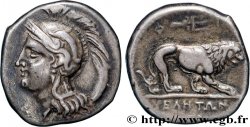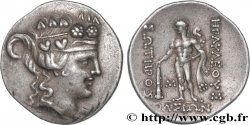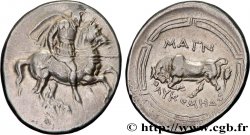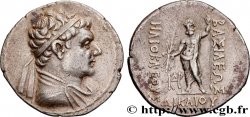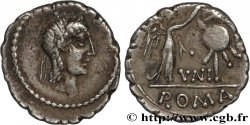bgr_1063374 - LUKANIEN - VELIA Nomos, statère ou didrachme
800.00 €
Menge
In den Warenkorb

Type : Nomos, statère ou didrachme
Datum: c. 305/304- 293/290 AC.
Name der Münzstätte / Stadt : Vélia, Lucanie
Metall : Silber
Durchmesser : 20,5 mm
Stempelstellung : 1 h.
Gewicht : 7,34 g.
Seltenheitsgrad : R1
Kommentare zum Erhaltungszustand:
Bel exemplaire, centré des deux côtés. Joli revers, bien venu à la frappe. Très beau portrait d’Athéna. Patine grise de collection
N° im Nachschlagewerk :
Pedigree :
Avec son étiquette ancienne (G. Morchio, numismate à Venise)
Vorderseite
Beschreibung Vorderseite Tête d'Athéna à gauche, coiffée du casque attique à cimier avec triple aigrette, orné d’un hippocampe ailé ; javeline pointé en avant ; monogramme devant le nez.
Legende des Averses F/ DE
Rückseite
Beschreibung Rückseite Lion passant à droite ; trident tourné à droite, au-dessus.
Legende des Reverses : UELHTWN/ F-I
Übersetzung der Rückseite (de Vélia).
Kommentare
Exemplaire signé sur le couvre nuque du casque. Mêmes coins que l’exemplaire de la collection Mc Lean (Cambridge, n° 1466) et que celui de l’Hunterian Coin Cabinet de Glasgow, n° 45. Très tôt, le monnayage de Vélia a été décrit comme ayant inspiré la drachme lourde de Marseille (LT. 785-791). Certains l’ont même décrit comme un monnayage symmachique : un lion de Vélia étant l’équivalent de deux lions de Marseille. Aujourd’hui, cette théorie est remise en cause, par G. Depeyrot, non sans arguments, mais avec une certaine acrimonie. Le lion de Vélia a pu servir de modèle à celui de Marseille, mais à quelle date ? La frappe à Vélia commence dans la seconde moitié du Ve siècle avant J.-C. pour se poursuivre jusqu’en 281 avant J.-C. À quel moment les Massaliotes auraient-ils emprunté le lion de Vélia ?.
example signed on the nape of the helmet. Same dies as the example in the McLean Collection (Cambridge, no. 1466) and that of the Hunterian Coin Cabinet in Glasgow, no. 45. Very early on, the coinage of Velia was described as having inspired the heavy drachma of Marseille (LT. 785-791). Some have even described it as a symmachic coinage: one lion of Velia being the equivalent of two lions of Marseille. Today, this theory is challenged, not without argument, but with a certain acrimony, by G. Depeyrot. The lion of Velia could have served as a model for that of Marseille, but at what date? Minting at Velia began in the second half of the 5th century BC and continued until 281 BC. At what point might the Massaliotes have borrowed the lion of Velia?
example signed on the nape of the helmet. Same dies as the example in the McLean Collection (Cambridge, no. 1466) and that of the Hunterian Coin Cabinet in Glasgow, no. 45. Very early on, the coinage of Velia was described as having inspired the heavy drachma of Marseille (LT. 785-791). Some have even described it as a symmachic coinage: one lion of Velia being the equivalent of two lions of Marseille. Today, this theory is challenged, not without argument, but with a certain acrimony, by G. Depeyrot. The lion of Velia could have served as a model for that of Marseille, but at what date? Minting at Velia began in the second half of the 5th century BC and continued until 281 BC. At what point might the Massaliotes have borrowed the lion of Velia?








 Berichten über einen Fehler
Berichten über einen Fehler Die Seite drucken
Die Seite drucken Teilen meiner Auswahl
Teilen meiner Auswahl Stellen Sie eine Frage
Stellen Sie eine Frage Einlieferung/Verkauf
Einlieferung/Verkauf
 Details
Details




